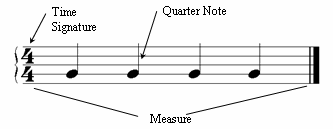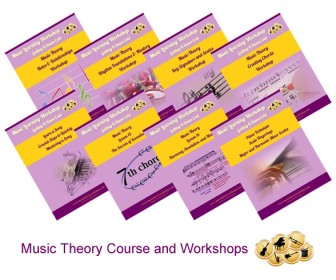Note Duration and Beat
Rhythm is expressed, stated, and describe with a time signature (time) and defines the note duration and time relationship.
Let’s examine the measure for 4/4 time.

FOUR / FOUR Time:
So here we have one of the most common time which is four-four time. We have found it easier to start with the bottom numeral to clarify what will be counted.
What the numbers mean: 
The bottom numeral is the duration or length of the beat and is the counting note; in this case the quarter note, therefore, each quarter note gets a count of 1 beat.
The top numeral is the number of beats per measure; so we will have 4 beats per measure. Count and clap: 1 – 2 – 3 – 4.
So put the 4/4 time another way. The counting will be done on quarter notes and there will be four counts per measure.
More below to help get this down cold.
Speed of Playing- Tempo
At this point we need to introduce how fast we clap these rhythms, our tempo. Do it slow at a speed you can control. Speed will be added and developed as you learn the rhythm.
Speed can be stated in terms of beats per minute. For our example
say quarter note = 60 means to play a quarter note with 60 beats per minute. Or play one quarter note per second. This is the baroque speed and is a great speed to learn simple rhythms.
If we used eighth note = 60 we would play an eight note every second. Which is twice as slow as a quarter note.
Wow, that’s a lot of fours in the previous pattern, let’s try another one, how about the waltz rhythm. We all dance to this one. It is counted: ONE, two, three. ONE, two, three.Accent on the one.
 Time Signature – Three Quarter Time:
Time Signature – Three Quarter Time:
Only 3 quarter notes in a measure

This time we are working with “three-four” time. How do we count it? Work it from the top numeral this time.
“3” represents number of beats per measure, count and clap 1 – 2 – 3.
“4” represents the time value of the beat – a quarter note.
The counting will be done with quarter notes and there will be three counts per measure.
Next up let’s count on an eighth note.
![]() Time Signature: (Six Eight Time)
Time Signature: (Six Eight Time)
What happens if we decide to use eight notes as our counting beat? Well, we can now make the bottom number an 8; so that every eighth note gets a count of 1.

This time we are working with “six-eight” time. How do we count it?
The bottom number: “8” represents the time value of the beat – an eighth note.
The top number “6” represents number of beats per measure,
count and clap 1 – 2 – 3 – 4 – 5 – 6.
The beat will be an eighth note and there will be 6 counts per measure.

